Vegetable Matchmaking - Companion planting in my kitchen garden
For about four years now, I’ve had the pleasure of building and maintaining a small kitchen garden out of raised beds in my backyard. Among the many tasks that go into planning a garden, from planning around the sunny spots to tilling the soil, me and my family engage in a game of sorts by plotting via companion planting. Companion planting is a technique in which certain crops are either planted together or kept separate to improve health, hardiness, productiveness and taste.
Since we also practice crop rotation and plant different vegetables depending on how we used the previous year’s produce, planning the garden presents an interesting challenge every season. There are a few staples in our garden, such as tomatoes, basil and peppers, but the layout of it typically undergoes significant changes. In this blog I will share this year’s garden, some of the choices we’ve made and some precautions for less-than-perfect pairings. If you’re looking to plant a kitchen garden in your own backyard, window ledge or rooftop (any space with access to light will do, really!), this might be useful as you’re planning out what to purchase.
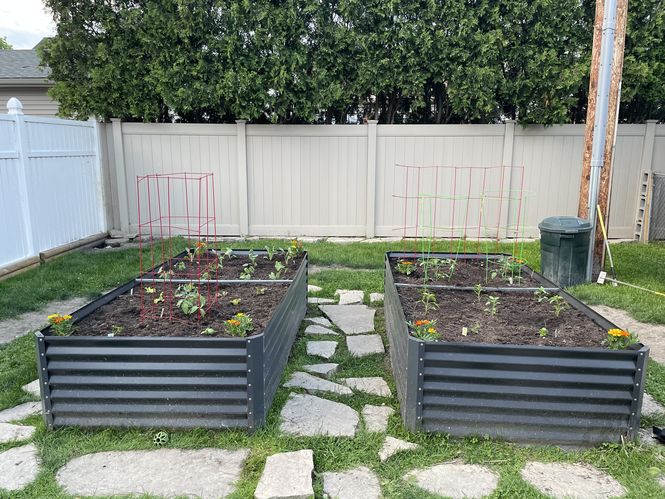
Raised Beds: Our beds are rectangular, industrial-style metal with a length of 2.4 m and a width of 1.2 m. Because I hail from a small suburban area just outside of Detroit, our yards typically do not include an abundance of green space. Our raised beds allow us to create a space specifically designed for gardening, from the fertilization and pH level of the soil to its water retention and temperature. Additionally, raised-bed farming increases soil productivity, allows for more aeriation and makes gardening altogether less strenuous.
When we initially constructed these boxes, we started by lining the bottom with a meshing that would keep weeds from sprouting up underneath. Then, we layered (from bottom to top) rocks for drainage, straw for moisture retention, grass clippings for compost and, finally, good-quality soil. Our boxes are situated in the only part of our backyard that receives full sun – good for most plants, but not for others. We must take care to plant shade-giving plants with shade-loving plants for this reason, but planting in full-sun generally has many benefits for vegetable gardens.
Corners: These are a free space, so to speak, on the botanical bingo card. Before planning anything else, we always place marigolds in the four corners of both boxes. These flowers are very beautiful and add a wonderful vibrancy to our garden, but they’re for more than just aesthetic value. Marigolds are important pest repellents for a whole host of unwanted critters, including mosquitoes, cabbage moths, whiteflies, aphids, root maggots, leafhoppers, squash bugs, Japanese beetles, slugs and tomato hornworms. In addition to keeping certain bugs away, they are also powerful attractors of pollinators such as bees and butterflies. Come June, our garden is alive with monarchs and honeybees alike enjoying the growing garden just as much as us.
These flowers’ benefit runs much deeper, however. Marigold roots ward off parasites and nematodes such as roundworm and threadworm by producing toxins that eliminate these root-ravaging pests. The blossoms are also edible and make a wonderful garnish for fancier platters, though they taste about as good as you might expect a flower to taste.
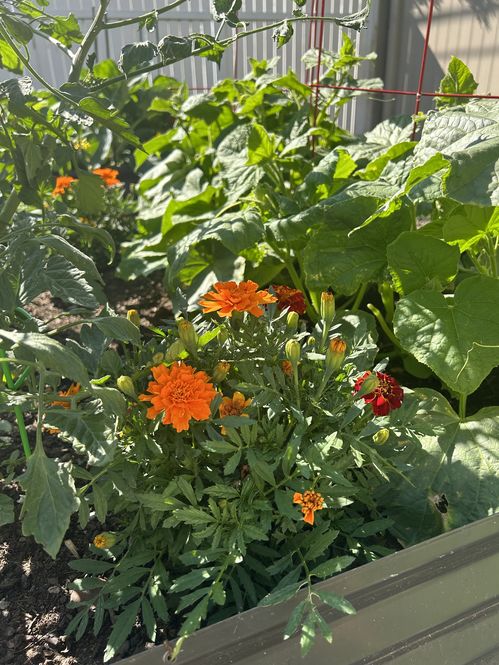
Front Row: The front row is where we planted the herbs. Herbs lend themselves well to companion planting because of their strong odours and essential oils, but that also makes them a bit tricky to get quite right. This year, we only planted four herbs: curled parsley, cilantro, Italian basil and dill.
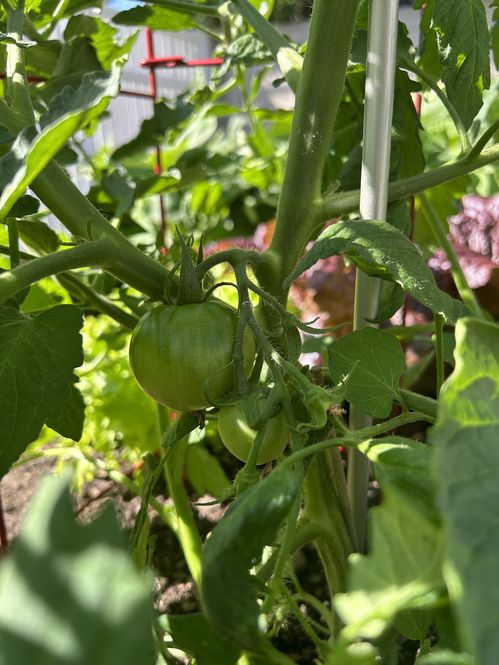
The choice of where to put the basil is easy; it goes where the tomatoes go. Basil provides just about every benefit possible to tomato plants, including root growth, productivity, facilitating germination, repelling pests, shading the soil and sharing nutrients to enhance tomato flavour. What herb to plant with this sweet leaf is slightly more difficult. Basil is a relatively delicate herb requiring a sunny and well-drained environment, and so it is not suitable for some herbs like rue or sage. It is, however, quite partial to both oregano and parsley; oregano, parsley, and basil require very similar growing conditions and attract mutually beneficial bugs such as hoverflies, which like to eat cutworms. On top of this, basil enhances the flavour of parsley and parsley helps the basil shade the tomato’s base.
In the other box, we made the slightly controversial choice to plant two very aromatic herbs together: the dill and the cilantro. In normal circumstances, one might want to stay away from planting these herbs together; however, given adequate room to grow, neither herb will overtake the other in flavour nor will they cross-pollinate. We planted these herbs together for the unique blend of benefits they lend to gardens, most notably increasing yield and repelling pests. Nevertheless, it’s best to avoid planting these two together if you can help it. If you can’t, make sure that the dill is at least 15 cm away from the cilantro. In our case, in the interest of privileging other pairings, we decided that the risk was a necessary one.
Front Middle: The middle of the garden is where the most differences arise. In the leftmost box we placed our largest tomato plant alongside two rows of mixed greens. This is a fairly innocuous coupling. Neither plant has much effect on the taste or growth of the other, but they do provide physical protection. Lettuce plants do well in sun, but they tend to prefer cooler environments – planting them next to tomatoes offers them the shade they need so as not to bolt and go to seed. In turn, the lettuce offers ground cover that keeps the roots of the tomato cool and prevents large weeds from sprouting. Together, they keep the soil moist and the temperature pleasant.
In the rightmost box, we simply put two rows of wax peppers. A small note about planting nightshades in a bunch like this: it’s very important that you space them out to let them breathe, otherwise the yield and quality of the produce will suffer. The cilantro, placed next to the peppers, is a wonderful companion. It not only improves the pepper’s taste, but it also repels common pepper pests like spider mites and aphids. Other trap, or decoy, plants that serve to lure aphids away from the peppers are very beneficial for peppers.
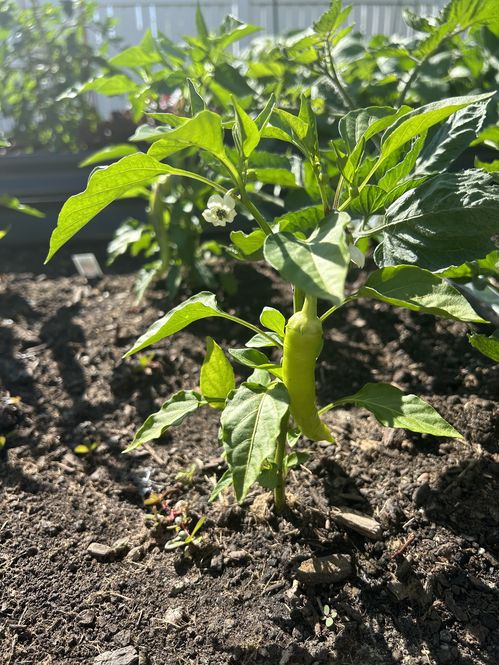
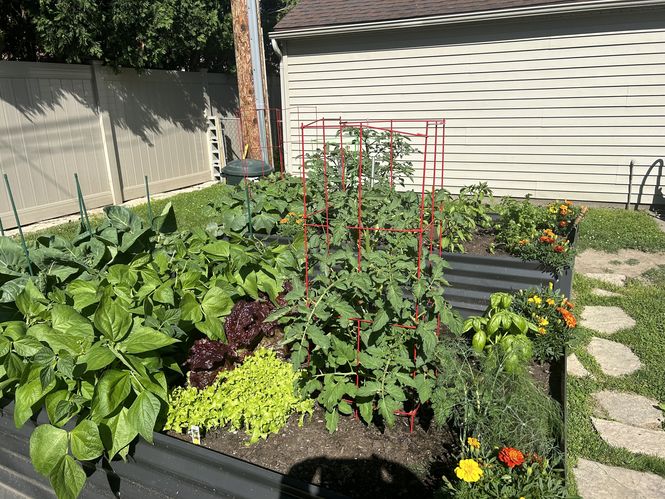
Back Middle: Directly across from the lettuce in the leftmost box are the bush beans. We prefer bush beans to pole beans because bush beans expand outward instead of upward – this means that don’t require stakes and help shade the lettuce. That’s not the only benefit they provide to the lettuce, however; bush beans, like other legumes, nourish the soil by fixing its nitrogen content, which is particularly essential for feeding the water-loving lettuce. The beans also act as a barrier between the lettuce and the Brussel sprouts, as planting the two leafy greens together could inhibit germination.
On the other side of the wax peppers in the rightmost box are more tomatoes, this time of the cherry variety. Both tomatoes and peppers, being closely related, share many of the same nutritional requirements. This unfortunately means that they are both susceptible to the same diseases and pests as well, so the location of your peppers and tomatoes should be rotated every single year if planting together. Maintaining healthy soil prevents the buildup of some of these common diseases and leads to happier, tastier and more fruitful plants.
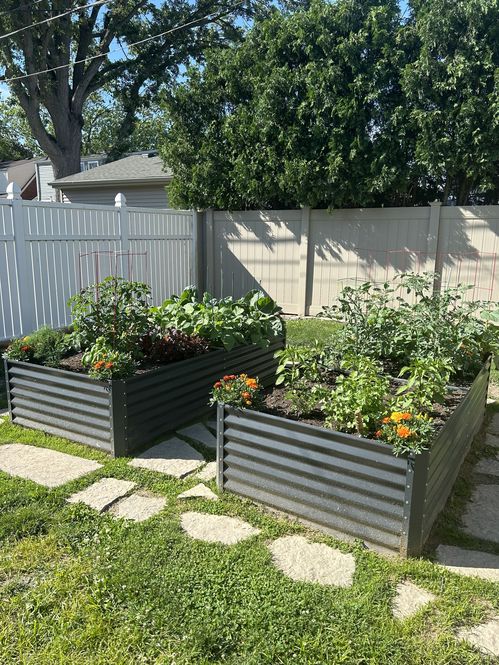
Back Row: The back row is where we plant the taller, or climbing, vegetables. In previous years, we’ve reserved this space for different types of cucumbers, aubergines, courgettes and summer squash. This year, we’ve decided on Brussel sprouts in the left box and Burpless cucumbers in the right. (Note: Burpless cucumbers are cucumbers that are bred to have less seeds – hence, they do not cause gastrointestinal issues, or burping. They’re comparable to English cucumbers.)
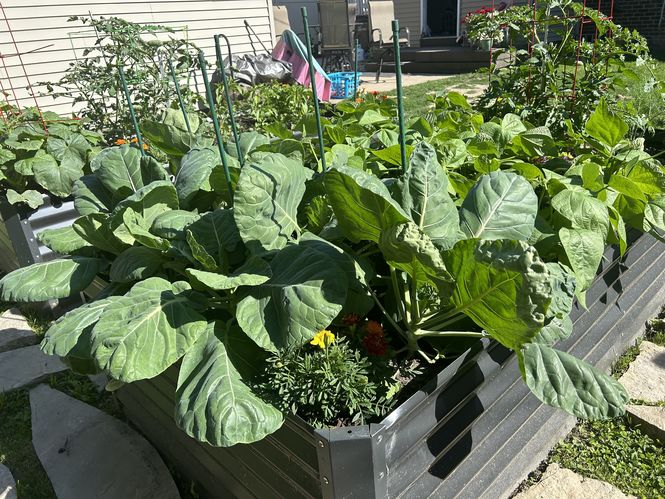
In the leftmost box, the nitrogen that the beans add to the soil is also beneficial for the Brussel sprouts, which are part of the same family as the lettuce. It’s important to note, however, that pole beans can have a detrimental effect on the growth of Brussels – another reason why we prefer bush beans. Some other plants that you should avoid planting with Brussels are members of the nightshade family, root vegetables, eggplants or mustard greens.
In the rightmost box, we have cucumbers growing on a trellis. Planting tomatoes next to the cucumbers makes maintenance easy since they share the same needs and aversions, but it’s important to strictly maintain both plants. Cucumbers and tomatoes tend to overreach, and so pruning is essential. Additionally, it’s a good idea to give both plants a frame (we’ve used a trellis for the cucumbers and cages for the tomatoes) for support; you can use this to guide their growing. And one last note: you should never plant potatoes next to cucumbers, because cucumber roots tend to encourage potato blight in the soil.
Certainly, a lot of planning goes into making the garden boxes. It’s a bit like Sudoku, trying to add or remove something in one spot without disturbing the harmony you’ve created in another. That’s part of the fun of it all I think, though it’s certainly a time-consuming process. It’s well worth it when your produce comes in far quicker, and tastes better than it would have on its own! Each plant has its own unique pairing, and many different guides or tools online can help you decide a suitable plotting pattern for your own unique sustainable kitchen garden.
If you’ve liked this article or found its content useful, consider checking out more garden design content here.


